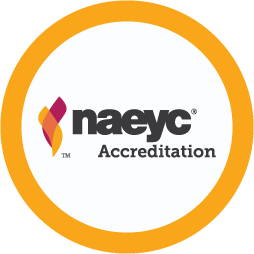Word Play Throughout the Day: Phonological Awareness in the Preschool Classroom

You are here
Ms. Diane and her preschoolers are preparing for snack time. As the children come to the table, she begins to play a rhyming game. “This chair is for someone whose name rhymes with ‘dawn,’” she says.
“Shawn!” shout the children.
“That’s right. Shawn, can you help me? Please give everyone something that rhymes with ‘dune.’”
“A spoon!” Shawn replies.
“Yes. We’re eating applesauce today, and we each need a spoon. ‘Spoon’ and ‘dune’ rhyme. They sound the same at the end.”
Activities like the one above help build children’s developing phonological awareness, or the awareness of the sound structure of an alphabetic spoken language (like English and Spanish) and the ability to manipulate it. As a speech-language pathologist and an early childhood educator, we (the authors) focus on the importance of authentic, play-based experiences for fostering preschoolers’ language development. In this article, we highlight specific phonological awareness skills, then offer suggested activities to help children develop them.
Identifying Phonological Awareness Skills
Phonological awareness skills emerge during the early years and continue to develop through elementary school. This means that the lessons and activities introduced by early childhood educators can build a strong foundation for literacy development later on. Specific skills (adapted from Literacy Learning for Infants, Toddlers, and Preschoolers: Key Practices for Educators by Tanya S. Wright and colleagues) include:
- Rhyming: Cheese and knees sound the same at the end.
- Alliteration: The words peanut and pasta start with the same sound.
- Sentence segmentation: It is raining has three separate words.
- Syllabification: Butterfly has three syllables (bu-tter-fly).
- Onset-rime blending and segmentation: The onset is the beginning consonant or blend (two consonants) of a word. The rime is the rest of the word. The /m/ sound can be blended with the rime /ap/ to make map (blending); the onset /t/ can be separated from the rime /op/ in the word top (segmentation).
- Phonemic awareness: Attending to the smallest units of sound (phonemes), such as the phonemes /h/, /o/, and /p/ within the word hop, or blending the sounds /t/, /i/, and /p/ to make the word tip.
(“Key Terms,” below, offers definitions for related yet different elements of sound and letter learning associated with an alphabetic language.)
Key Terms
Phonological awareness: A broad term that refers to the awareness of the sound structure of an alphabetic spoken language, including the ability to manipulate it.
Phonemic awareness: A subskill of phonological awareness that refers to the ability to identify and manipulate the smallest unit of sound that distinguishes one spoken word from another.
Phoneme: An individual unit of sound that can distinguish one word from another (for example, /b/ and /m/ are different phonemes in English because bat and mat are different words).
Grapheme: A symbol (in English and Spanish, for example, a letter or set of letters) that represent(s) a phoneme.
Alphabetic principle: The understanding that alphabet letters represent spoken sounds in a systematic way.
Phonics: An instructional practice that explicitly maps graphemes onto phonemes.
Spelling: Connecting phonemes to graphemes to represent spoken words in print.
Source: Literacy Learning for Infants, Toddlers, and Preschoolers: Key Practices for Educators, by Tanya S. Wright, Sonia Q. Cabell, Nell K. Duke, and Mariana Souto-Manning (2022)
Introducing Phonological Awareness Activities
Because preschoolers learn best through a combination of planned and spontaneous learning experiences, effective phonological awareness instruction incorporates some planned small- and/or large-group instruction as well as learning opportunities like the one in the opening vignette. It’s important to include children’s home languages and other aspects of their social and cultural contexts when planning these activities. Consider incorporating words in a child’s home language, using a nursery rhyme or familiar story that is important to the family’s culture, and sharing fingerplays that families can use in their home languages.
Remember that children do not need to master one skill before moving on to another; rather, teachers can introduce these concepts at the same time. Following are some ideas for playful activities that teachers can incorporate throughout the learning day that integrate movement, songs, books, and creative expressions.
- Embed rhymes to help develop rhyming skills. For example, recite “Humpty Dumpty” as children build with blocks or play in the kitchen. Say “Pat-A-Cake” as children play with clay. Send children on a rhyme search: ask them to find something that rhymes with “cook” (“book”), “rink” (“sink”), and “boar” (“door”). Or use a rhyming word instead of a child’s name to call on them (as in the opening vignette). There are a variety of engaging rhyming books to read aloud with children, such as Families, Families, Families, by Suzanne Lang, Frog on a Log?, by Kes Gray, and Billy Bloo Is Stuck in Goo, by Jennifer Hamburg. Also consider tapping into favorite rhyme and rhyming books from children’s homes or communities.
- Read books rich in alliteration. Pete the Cat and the Perfect Pizza Party, by James and Kimberly Dean, The Worrywarts, by Pamela Duncan Edwards, and Old MacDonald Had a Dragon, by Ken Baker, are some of our favorites. Along with stopping to note and play with the alliteration in these texts, practice this skill by adding a word before a child’s name that starts with the same sound (Jumping Jada, Charming Charles).
- Practice sentence segmentation by counting the words in familiar sentences. For example, tell the children “It’s time to get our coats,” counting the six words with your fingers as you speak.
- Introduce movement into syllabification by clapping, hopping, or stomping each syllable. Bring in musical instruments (drums, tambourines, rhythm sticks), and ask children to hit them for each syllable.
- Use your hands or objects (magnetic tiles, puzzle pieces, blocks, or pieces of playdough) to illustrate onset-rime blending and segmenting. For blending, face the children and hold out your right hand (by itself or holding an object) as you say the onset, then your left hand (with or without an object) as you say the rime. Move your hands or the objects together as you say the whole word. When practicing segmenting, begin with your hands or the objects together, then move them apart as you segment the word into its onset and its rime.
- Build phonemic awareness skills by calling children’s attention to the smallest unit of sounds in familiar words, such as pointing out two names that start with the same sound or telling the children, “It’s cold outside. We will all need to wear something on our heads that starts with /h/.”
Conclusion
Phonological awareness is critical for children’s literacy development. As these skills develop in the preschool years, we should incorporate them into our daily practices. Word play that includes movement and manipulatives will help you target phonological awareness in developmentally appropriate ways that are also playful and joyful.
Photograph: © Getty Images
Copyright © 2024 by the National Association for the Education of Young Children. See permissions and reprints online at NAEYC.org/resources/permissions.

 This article supports the following NAEYC Early Learning Programs standards and topics
This article supports the following NAEYC Early Learning Programs standards and topics
Standard 2: Curriculum
2D: Language Development
2E: Early Literacy
2J: Creative Expression and Appreciation for the Arts
Anne Gritt, MS, CCC-SLP, is a clinical assistant professor and speech-language pathologist in the Department of Speech, Language, and Hearing Sciences at Purdue University in West Lafayette, Indiana, where she coleads the Preschool Language Program, a preschool for children with developmental language disorder and a clinical education site for students.
Kalie Standish, MEd, is the early childhood specialist/coleader of early childhood programs in the Department of Speech, Language, and Hearing Sciences at Purdue University. Kalie has over 15 years of experience working in early childhood education, including home visiting, special education, preschool director/teacher, and coaching and mentoring.